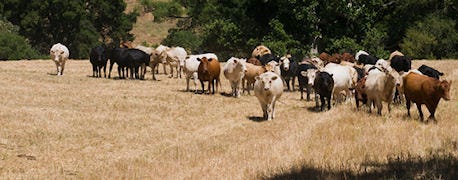March 17, 2014

Improved management adapted to changing rangeland conditions will be a key to surviving three back-to-back years of drought, according to Tim Steffens, Texas A&M AgriLife Extension Service rangeland management specialist in Canyon, Texas.
Three back-to-back drought years have left very little grass in some pastures, and recovery will be a long-time coming.
"We have just had three of the driest growing seasons in recorded history in a row," said Steffens, who is also a West Texas A&M University assistant professor. He spoke at the recent Panhandle Ranch Management event.

Adapting to damaged range in the Southwest will require more intensive management
"We've had one of the driest falls. We've had one of the driest winters. So this coming year, don't be in any hurry to increase numbers until we find out for sure how much rain we've got, and how much grass we're going to have that can respond to further rain showers later in the year."
Related: President Reauthorizes Drought Data System
Steffens warned that if grass starts in bad shape from last year, it probably will remain in trouble this year, even if it rains normally.
"If we don't get rain in the spring to get things started and have some grass growing by mid-June, it's probably not going to be a good year. So by early July, you need to assess the conditions and make decisions then. Then look again in the fall and determine if you have enough grass and if you have had enough rain to take care of the grass."
Steffens said keys to management include providing adequate recovery for grass before grazing, which means letting the plants get a full complement of leaves before cattle regraze a plant.
Provide adequate recovery
A grazing "system" that does not provide adequate recovery following grazing won't do much good, he said. Whatever management strategy a rancher chooses, adequate recovery for severely defoliated plants and leaving enough residue after a grazing period "is what is going to get you where you want to go."
~~~PAGE_BREAK_HERE~~~
Steffens said grazing decisions can prepare resources to respond favorably in the good times or not go down so far when things are not good.
"Right now, I am not worried about weeds," he said. "If it will grow, I'm tickled to death. Get something to cover up that ground, provide some shade, protect it from the wind, keep it from eroding and provide some cover so that something can grow later."
Related: Drought Monitor: Cali Unchanged, Small Degradations in the Plains
5 management tips
• Provide adequate regrowth for heavily defoliated plants, and do that every year, if possible.
• Improve distribution – get the animals away from the places they are overusing and get them to places they are underusing.
• Provide every opportunity for recruitment of new plants. Most plants in pastures reproduce vegetatively; they don't have to come up from seed. But some areas may need more seed. "If you have to have the seed, try to get some. But I wouldn't advise going out there and wasting money now trying to plant."
• Maintain stocking rate within carrying capacity. "If you are overstocked, I don't care what you do, you are a numerical failure going in."
• Maintain or improve resilience of the plant community. A variety of plants in unstable conditions is a positive thing; there's always something there to respond to rain.
Hay won't do the trick
Steffens said feeding hay on rangeland does not stop overgrazing, because if any grass does grow, the cattle will go to it before eating the hay.
"Get cattle out of abused areas and to areas that still have feed," he said. "If you have to continue to feed cattle, I suggest getting them into a pen and feeding them there, where they won't be overgrazing plants."
He said "planting fence posts and pipe" or dividing up pastures and allowing periods of rest for the grass may be more cost effective than planting or buying hay.
Source: Texas A & M
You May Also Like




